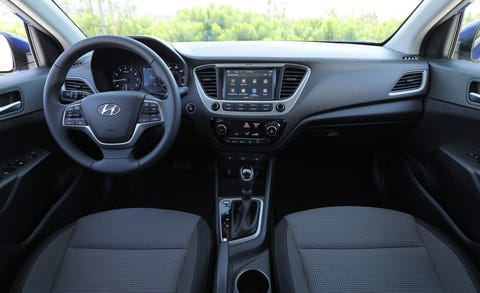Just because a car is cheap doesn’t mean it needs to look cheap, and the 2022 Hyundai Accent offers dignified styling despite its bargain-basement price tag. All models come with a 120-hp four-cylinder engine with a continuously variable automatic transmission (CVT). It’s not exciting, but it gets the job done and does so while sipping fuel.
The interior, which is also unexciting but functional, offers modern conveniences and even some luxuries. The loaded Limited model costs less than $21,000 and offers heated seats, touchscreen infotainment, and push-button start. No matter which trim you choose, the Accent’s appearance is mature and contemporary, saving you from the embarrassment of being outed as a penny pincher.
Engine, Transmission, and Performance
The 2022 Hyundai Accent’s 1.6-liter four-cylinder engine makes 120 horsepower and drives the front wheels through a continuously variable automatic transmission (CVT). The four-cylinder was new for 2020, and we’ve not tested one, but we expect performance similar to the 2018 and 2019 models, which offered 130 horsepower. It’s clear that ride comfort takes priority over deft handling. Still, the Accent feels lively, its small body is easily tossed into corners, and it’s even rewarding when pushed. Rough roads are smoothed out adequately by the suspension, but harsh impacts will generate vibrations through the cabin.

Fuel Economy and Real-World MPG
Small cars are expected to deliver good fuel-economy numbers, and the Accent does just that. The new four-cylinder engine has improved fuel economy to a 36 mpg combined rating. We haven’t had the chance to put the Accent’s new powertrain through our real-world highway fuel-economy testing, but when we do, we’ll take it on our 75-mph highway fuel economy test route and update this story with test results. For more information about the Accent’s fuel economy, visit the EPA’s website.
Interior, Comfort, and Cargo
The 2022 Hyundai Accent‘s grown-up interior seems well built, but it lacks the cheeky style of the Kia Rio or the rear-seat spaciousness of the Honda Fit—which provides nearly six inches of additional rear legroom. Sporting a frill-free interior design, the Accent is uncomplicated and honest. Both of our test cars had a black interior, which, although well built, provided a somber, businesslike appearance.
The optional beige interior imparts a richer feeling, with two-tone tan and black seats and a similar treatment for the dash and door panels. Despite its sedan body and a smaller amount of cargo space with the rear seats in use, the Accent had room for more of our carry-on cases than did its more practically shaped hatchback Rio. In fact, with its rear seats folded, the Accent held just two fewer cases than the especially spacious Fit.
Infotainment and Connectivity
A 5.0-inch touchscreen radio is standard and provides USB and auxiliary ports for connecting devices to the interface, but the 7.0-inch touchscreen infotainment system that comes on SEL and Limited trims is higher tech. The larger display also boasts Apple CarPlay and Android Auto connectivity as well as a second USB port located on the back of the center console. Both systems offer Bluetooth phone connectivity, but the 7.0-inch touchscreen also comes with SiriusXM satellite radio.
Safety and Driver-Assistance Features
Automated emergency braking and forward-collision warning are optional driver-assistance features not offered on many of the Accent’s rivals. For more information about the Accent’s crash-test results, visit the National Highway Traffic Safety Administration (NHTSA) and Insurance Institute for Highway Safety (IIHS) websites.


